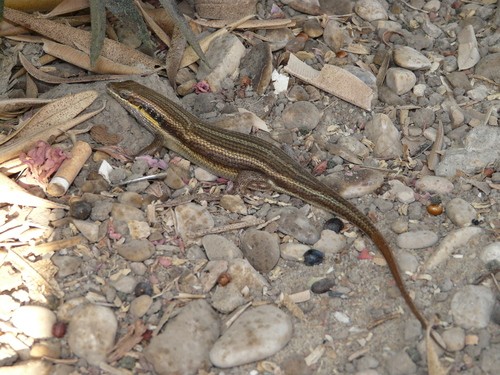Trachylepis quinquetaeniata quinquetaeniata
A species of Afro-malagasy mabuyas Scientific name : Trachylepis quinquetaeniata quinquetaeniata Genus : Afro-malagasy mabuyas
Trachylepis quinquetaeniata quinquetaeniata, A species of Afro-malagasy mabuyas
Scientific name: Trachylepis quinquetaeniata quinquetaeniata
Genus: Afro-malagasy mabuyas
Content
Description General Info
 Photo By jujurenoult , used under CC-BY-4.0 /Cropped and compressed from original
Photo By jujurenoult , used under CC-BY-4.0 /Cropped and compressed from original Description
Trachylepis quinquetaeniata quinquetaeniata is a creature known for its unique diurnal activity and abundance in various habitats, from rock-strewn fields to urban areas. The profound adaptability of this skink manifests in its omnivorous diet, enabling it to consume a breadth of food organisms, ensuring its survival across diverse geographical territories. Key to its reproductive success is the laying of eggs in humid environments, exhibiting an evolutionary strategy for offspring survival.
General Info
Lifespan
8-10 years
Diet
Trachylepis quinquetaeniata quinquetaeniata is an omnivorous skink, primarily feeding on insects, including ants, beetles and cockroaches. Ample consumption of plant material, mainly leaves, flowers and seeds, supplements its diet.
Appearance
Trachylepis quinquetaeniata quinquetaeniata is a medium-sized skink with scales covering its elongated, cylindrical body. It sports a vibrant pattern of five parallel stripes, running longitudinally down its body from head to tail. Its principal coloration is dark-brown or black, adorned with pale, cream-colored stripes. Its features include a pointy snout and a slender tail which might be twice the length of its body. There are no notable differences in appearance due to age or gender.
Behavior
Trachylepis quinquetaeniata quinquetaeniata is a diurnal, terrestrial lizard notable for its skittish, quick movements. Mostly solitary, it’s highly protective of its territory, deterring intruders through tail display and aggressive posturing. Its survival in arid environments is facilitated by significant adaptations, including the ability to derive moisture from the food it consumes.